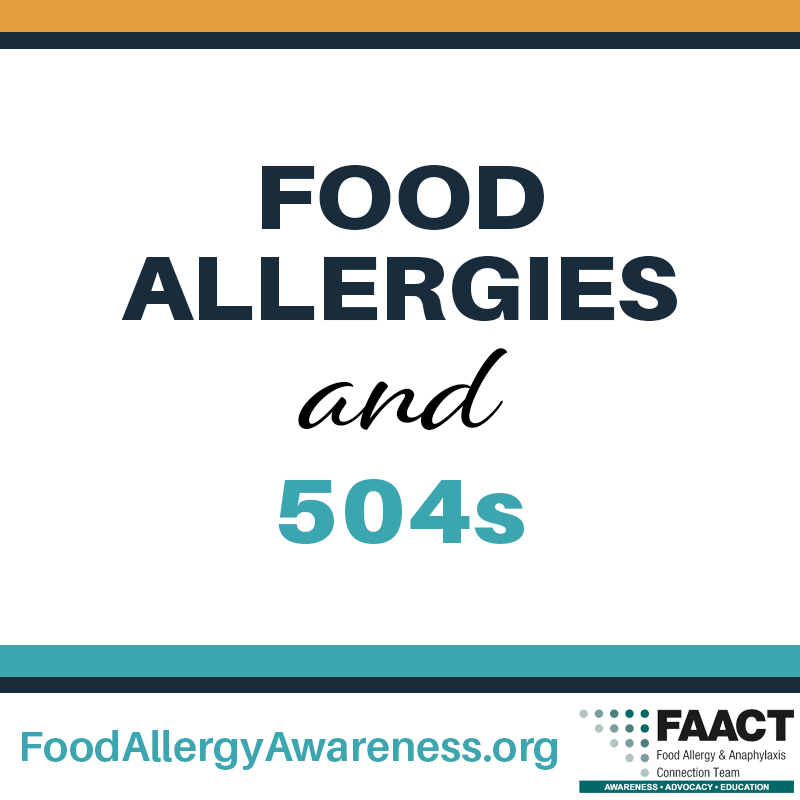Accommodations

Section 504 Plans
Section 504 of the Rehabilitation Act of 1973 prohibits programs and activities that receive federal financial assistance, such as public schools, from discriminating against and/or excluding individuals with disabilities solely on the basis of their disability. Public school districts, institutes of higher learning, some early childcare education centers, and other state and local educational agencies are types of institutes that receive federal funding and thus must comply with Section 504.
The most common educational application of Section 504 occurs in public, K-12 schools, where Section 504 requires a school district to provide a “free and appropriate public education” (FAPE) to each qualified, disabled student, regardless of the nature or severity of that student’s disability. To be a qualified student with a disability under Section 504, the student must fall into one of three categories: (1) the student must have a physical or mental impairment that substantially limits one or more major life activities, (2) the student must have a record of such impairment, or (3) the student must be regarded as having such an impairment. The regulatory provisions for Section 504 specifically define a “physical or mental impairment” and “major life activities,” the definition of which was expanded by the Americans with Disabilities Act (ADA) Amendments Act of 2008. Under the current law, “major life activities” can include caring for oneself, performing manual tasks, walking, seeing, hearing, eating, speaking, breathing, learning, working, sleeping, standing, lifting, bending, reading, concentrating, thinking, and communicating. Additionally, Congress defined “major bodily functions” such as immune system, normal cell growth, digestive, bowel, bladder, neurological, brain, respiratory, circulatory, endocrine, and reproductive functions as “major life activities.” It is important to note that these were merely examples given by Congress and were not intended to be an exclusive list of “major life activities.”
What Is the Significance of Section 504 to a Student with Food Allergies?
Students with food allergies are at risk for anaphylaxis, a life-threatening condition that can significantly impact the “major life activity” of breathing. Food allergies may also significantly limit other major life activities such as digestion and eating. As such, students with food allergies may be entitled to accommodations under Section 504, typically referred to as a “504 plan.”
Accommodations under Section 504 are meant to provide a student with a disability access to education equal to that of his non-disabled peers. In other words, accommodations under Section 504 do not give preferential access. Instead, they are intended to level the playing field for the student with a disability – in this case, a food allergy. It is likely that the food-allergic student enters the school environment already at a disadvantage due to an unsafe environment that promotes exclusion or a lack of food allergy education among school educators. Section 504 provides a written plan to safely include the student in all programs and activities provided or sponsored by the school. When the school provides a safe, inclusive environment, the food-allergic student has the opportunity to access education and activities on equal footing with his or her non-disabled peers.
Referrals and Eligibility
School districts should identify students with health impairments and notify their parents of the right to be evaluated for a Section 504 plan. These students may be identified by reviewing students who have current Individual Health Plans (IHPs), identifying students who are currently developing IHPs, or by sending a mass message describing eligibility requirements for those with specific health impairments (e.g., diabetes, food allergies, etc.) and the process of eligibility. The school district should decide what is the best form of identifying students.
Parents may also refer their child for a Section 504 evaluation. The referral should be made in writing, with the date included, to the school administrator, giving permission for the evaluation and testing. Once the school receives the referral, this starts a timeline. School districts may have different timeline procedures. However, schools generally have a certain number of days to respond to the parent or legal guardian after a referral has been made. Another meeting may be scheduled to determine appropriate accommodations. Discussions about accommodations should take place during meetings, and all accommodations should be documented in the 504 plan. Discussions about accommodations made outside the meeting environment are ineffective, especially if not written in a plan.
Do 504 Plans Create Antagonism Between School Staff and Parents?
A common argument for not seeking a 504 plan is that doing so will create an antagonistic situation with the school district staff and/or the parents of non-disabled peers in simply making the request. This is not true.
Accommodations under Section 504 are not intended to give preferential treatment. Under Section 504, disabled students are to be accommodated to the maximum extent necessary to be safely included and allowed access alongside their non-disabled peers. Furthermore, educators want the best for their students and are happy to know how to manage a student’s health and well-being. Section 504 plans set out specific instructions and plans to ensure a disabled student’s well-being and safety. They are a tool for educators to use to assist them in supervising our children when they are in the educators’ care. There is nothing inherently antagonistic about that.
Animosity and antagonism can be felt due to projected or perceived emotions. In all communications and dealings with school personnel, it is important to remember this and remain calm and factual. Visit our Civil Rights Resource Center for a sample list of common accommodations.
FAACT
Did you know that even if the health impairment is not active, a student may still be considered “disabled” under ADA Amendments Act if the impairment substantially limits a major life activity when active? For example, a food-allergic student does not constantly experience anaphylaxis. However because anaphylaxis substantially limits major life activities (such as breathing) when it is active, the food-allergic student is considered disabled and qualify for accommodations under Section 504 of the Rehabilitation Act.
For further civil rights advocacy assistance, contact Amelia.Smith@FoodAllergyAwareness.org.